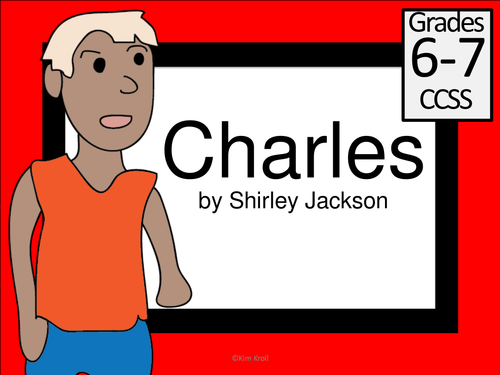


This is a complete lesson for the short story “Charles” by Shirley Jackson. No prep necessary!
This product includes:
---3 day lesson plan in EATS format (including an activating strategy, teaching strategies, and more…)
---4 printable worksheets (including comprehension questions, writing prompts, exit tickets, and more…)
---Answer Keys
---41- Slide PowerPoint (including methods of characterization, PALS reading strategy, Sample Answer for the Essential Question, and more…)This is a great short story for the middle school!
The lesson discusses: explicit details vs. implicit details, inferring, static vs. dynamic characters, and theme. During the three days, students are given the opportunity to work independently, in pairs, in groups, through writing, through speech, etc. Various activities will help with differentiated learning.
This lesson is particularly effective in helping students answer the Essential Question (How can a reader determine theme of a text?) because a sample student answer is given for the class to critique. Students will independently answer the E.Q. at the culmination of the lesson (on Day 3!).
I hope you enjoy this lesson !
This lesson is Common Core aligned to: CCSS.ELA-Literacy.RL.6.1 Cite textual evidence to support analysis of what the text says explicitly as well as inferences drawn from the text.
CCSS.ELA-Literacy.RL.6.2 Determine a theme or central idea of a text and how it is conveyed through particular details; provide a summary of the text distinct from personal opinions or judgments.
This product includes:
---3 day lesson plan in EATS format (including an activating strategy, teaching strategies, and more…)
---4 printable worksheets (including comprehension questions, writing prompts, exit tickets, and more…)
---Answer Keys
---41- Slide PowerPoint (including methods of characterization, PALS reading strategy, Sample Answer for the Essential Question, and more…)This is a great short story for the middle school!
The lesson discusses: explicit details vs. implicit details, inferring, static vs. dynamic characters, and theme. During the three days, students are given the opportunity to work independently, in pairs, in groups, through writing, through speech, etc. Various activities will help with differentiated learning.
This lesson is particularly effective in helping students answer the Essential Question (How can a reader determine theme of a text?) because a sample student answer is given for the class to critique. Students will independently answer the E.Q. at the culmination of the lesson (on Day 3!).
I hope you enjoy this lesson !
This lesson is Common Core aligned to: CCSS.ELA-Literacy.RL.6.1 Cite textual evidence to support analysis of what the text says explicitly as well as inferences drawn from the text.
CCSS.ELA-Literacy.RL.6.2 Determine a theme or central idea of a text and how it is conveyed through particular details; provide a summary of the text distinct from personal opinions or judgments.
Get this resource as part of a bundle and save up to 40%
A bundle is a package of resources grouped together to teach a particular topic, or a series of lessons, in one place.
Something went wrong, please try again later.
This resource hasn't been reviewed yet
To ensure quality for our reviews, only customers who have purchased this resource can review it
Report this resourceto let us know if it violates our terms and conditions.
Our customer service team will review your report and will be in touch.
$3.00